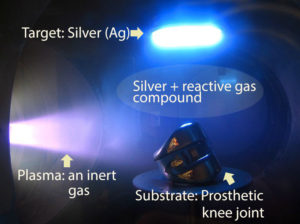Customized valve response algorithms in flow controllers produce better films, with more control of the target’s transition state.
Reactive Sputtering

Reactive Sputtering is a type of Physical Vapor Deposition process used to create thin film vacuum coatings. The process deposits a compound material coating on a substrate by introducing a reactive gas, such as O2 or N2, into a plasma typically generated using an inert gas, such as Argon. The reactive gas is activated by the plasma, and then chemically reacts with a “target”—normally consisting of metals, alloys or ceramics—producing a coating material which is deposited on a substrate. The resultant oxide, nitride or carbide coating imparts properties such as low emissivity or durability to the substrate that is coated.
Reactive Sputtering deposition is very commonly used in manufacturing and R+D processes, such as:
- Flat-panel displays for televisions and cell phones
- Photovoltaic coatings on solar cells
- Optical coatings on sunglasses
- Decorative coatings on hardware and automotive components
- Insulating coatings on architectural glass
Alicat mass flow controllers are compatible with the most common reactive gases. Those gases—and some of their typical compounds—are:
- Oxygen (O2) – creating oxides such as Al2O3, SiO2, TiO2, ITO (Indium Tin Oxide)
- Nitrogen (N2) – producing nitrides such as TiN, ZrN, CrN
- Acetylene (C2H2) or Methane (CH4) – for diamond-like carbon films
Controlling the sputtering process
By controlling the amount and timing of reactive gas flows, deposition rates and film properties can be adjusted with some precision. Using flow control does not require active feedback, but the deposition rate is lower compared to closed-loop control, and film properties can be less than optimal.
A closed-loop control of partial pressure provides higher deposition rates versus flow control and the film properties are improved. But closed-loop control requires active feedback control, increasing the complexity and expense of the process. Equally important is that the system respond swiftly and precisely to the feedback, to ensure a good coating. Since reactions are electrochemical, and may take place in milliseconds of exposure of the target to the gas or the substrate to the plasma cloud, the control requirements can be very tight.
Closed-loop control systems measure process conditions in real-time through feedback signals. Commonly used feedback signals include:
- Target voltage
- Optical emission from plasma, often called Plasma Emission Monitoring or PEM
- Partial pressure of reactive gas, measured by a Residual Gas Analyzer or RGA
Avoiding Target Poisoning
Another important variable in determining deposition quality is the condition of the target during the sputtering process. Increasing reactive gas flow to the process speeds the chemical reaction, but can also cause full coverage of the target or “target poisoning”. When target poisoning occurs, the process can be negatively affected. A decreased deposition rate, as well as unwanted changes in vacuum and voltage levels can occur which can damage both the target and the substrate. Closed-loop process control systems are used to maintain the “transition” state of the target, and avoid poisoning.
Closed-loop control is also more flexible than flow control coating, allowing for multi-gas and multi-zone process control. Alicat MFCs provide field-adjustable PID programmability for coating experts to attain the fastest response speed of any mass flow controller, improving process stability and coating chamber conditions. PID and PDF+ algorithms optimize control by altering the rate and manner of response control commands. Multiple PID algorithms are available, allowing the user to generate the best possible flow control response to any process control signals.

Alicat MFCs are compatible with mechanical and electrical connections used on existing sputtering tools, and are often used as a means to upgrade or update process controls. Many digital and analog interfaces are available, including RS-232 and RS-485. They can be combined with protocols such as DeviceNet and EtherNet/IP.
Alicat mass flow controllers include the Gas Select™ feature. With it, you can easily switch gases without the need for K-factor calculations or other compensation, because each MFC contains a database of gas properties covering the full range of operating pressures and temperatures. Combining Gas Select with an expansive 200-to-1 control range, users greatly reduce the number of different MFCs necessary to meet the demands of reactive sputtering.
Alicat’s Applications Engineers can help you find the best mass flow controllers for your reactive sputtering application. Contact them using our online chat system, call in, send us a question on a web form or email info@alicat.com.